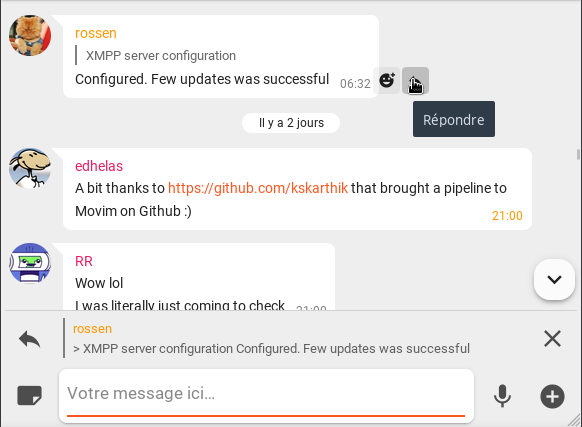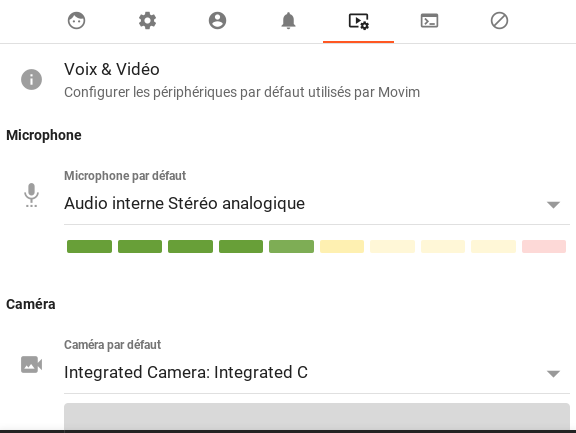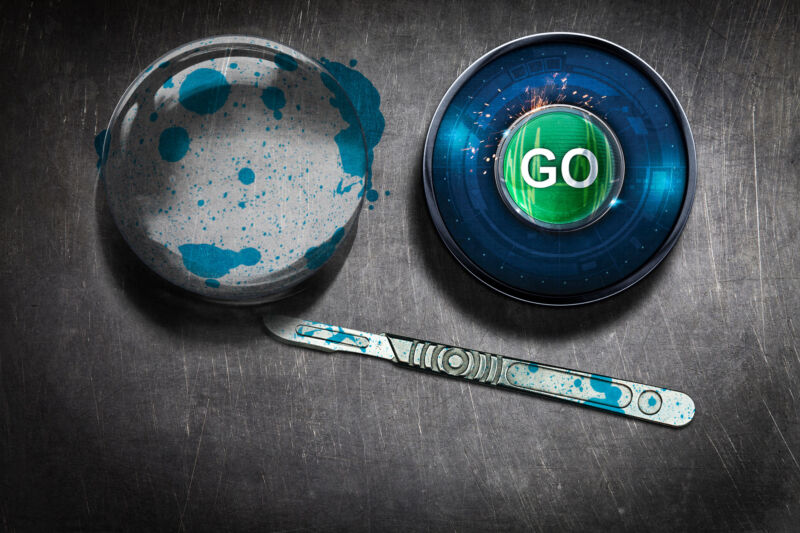-
 chevron_right
chevron_right
Cyber Monday 2023: The best deals on Lenovo, Herman Miller, Apple, Anker, Dyson, and more
news.movim.eu / ArsTechnica · Monday, 27 November - 12:30 · 24 minutes

Black Friday has come and gone, but that doesn't mean that holiday deals are ending. Retailers are capitalizing on the days following Thanksgiving to entice shoppers to spend, and that's a win for consumers. With Cyber Monday and Cyber Week discounts on the top tech products, you can score some terrific deals on leading brands, like Apple, Lenovo, Microsoft, Sony, Dyson, Bose, and more. We'll update our curated Dealmaster regularly throughout the week, so check back frequently for the best sales and discounts.
Also, check out our full coverage for Black Friday 2023 deals, buying guides, and gift guides:
- Framework Laptop prices go as low as $639 thanks to refurbs and “factory seconds”
- Do the Black Friday e-bike deals change the price/performance equation?
- These newest vacuums from 2023 clean up well, and they’re on sale
- The best Black Friday 2023 headphone deals from Apple, Bose, and more
- The best soundbar and TV deals for Black Friday 2023
- Black Friday 2023 laptop deals from Dell, HP, Lenovo, Apple, Microsoft, and more
- Guidemaster: A quick gaming iPhone gift guide
- Guidemaster: Smart kitchen appliances for the modern home cook
- Guidemaster: The most interesting, odd smartphone accessories we could find
Lenovo
- IdeaPad 1 (15-inch, AMD Athlon Gold 7220U) for $180 (was $400) at Lenovo
- Slim 71 (14-inch, Intel Core i5-1340P) for $700 (was $1,180) at Lenovo
- ThinkPad L14 Gen 3 (14-inch, AMD Ryzen 5 Pro 5675U) for $589 (was $2,659) at Lenovo
- ThinkPad X1 Carbon Gen 11 (14-inch, Intel Core i7-1365U) for $1,400 (was $3,559) at Lenovo
- IdeaPad Slim 3i (15-inch, Intel Core i3-1315U) for $400 (was $660) at Lenovo
- IdeaPad Slim 3i Chromebook Plus (14-inch, Intel Core i3-N305) for $350 (was $550) at Lenovo
- ThinkPad X1 Carbon Gen 10 (14-inch, Intel Core i7-1280P) for $1,100 (was $3,929) at Lenovo
- ThinkPad X1 Carbon Gen 11 (14-inch, Intel Core i5-1335U) for $1,000 (was $2,609) at Lenovo
- Legion Slim 5 Gen 8 (16-inch, AMD Ryzen 5 7640HS and RTX 4050) for $930 (was $1,300) at Lenovo
- IdeaPad Slim 5i (16-inch, Intel Core i5-1335U) for $580 (was $930) at Lenovo
- Yoga 6 (13-inch, AMD Ryzen 7 7730U) for $700 (was $1,100) at Lenovo
- ThinkPad P16v (16-inch, Intel Core i7-13700H and RTX A500) for $1,299 (was $3,339) at Lenovo
- 14w Gen 2 (14-inch, AMD 3015e) for $254 (was $424) at Lenovo
- Lenovo 3i Chromebook (15-inch, Intel Pentium Silver N6000) for $250 Doorbuster price starting at 9AM ET on 11/27 (was $440) at Lenovo
- Tab P12 (12.7-inch, MediaTek Dimensity 7050) for $250 Doorbuster price starting at 9AM ET on 11/27 (was $350) at Lenovo
- ThinkPad L14 Gen 3 (14-inch, AMD Ryzen 5 Pro 5675U) for $599 Doorbuster price starting at 9AM ET on 11/27 (was $2,688) at Lenovo
- IdeaPad Slim 3 (15-inch, AMD Ryzen 5 7530U) for $400 Doorbuster price starting at 10AM ET on 11/27 (was $700) at Lenovo
- IdeaPad Flex 5 (14-inch, AMD Ryzen 5 7530U) for $440 Doorbuster price starting at 10AM ET on 11/27 (was $740) at Lenovo
- Legion Pro 5i Gen 8 (16-inch, Intel Core i5-13500HX and RTX 4050) $1,035 Doorbuster price starting at 10AM ET on 11/27 (was $1,480) at Lenovo
- ThinkPad P16s Gen 2 (16-inch, Intel Core i7-1360P and RTX A500) for $1,419 Doorbuster price starting at 11AM ET on 11/27 (was $3,629) at Lenovo
- IdeaPad Pro 5i (16-inch, Intel Core i5-13500H and RTX 3050) for $800 Doorbuster price starting at 12PM ET on 11/27 (was $1,500) at Lenovo
- ThinkPad E16 Gen 1 (16-inch, AMD Ryzen 5 7530U) for $630 Doorbuster price starting at 12PM ET on 11/27 (was $692) at Lenovo
- Legion Tower 7i Gen 8 (Intel Core i7-13700KF and RTX 4080) for $2,100 Doorbuster price starting at 12PM ET on 11/27 (was $2,900) at Lenovo
- ThinkPad P16s Gen 2 (16-inch, Intel Core i7-1360P and RTX A500) for $1,089 Doorbuster price starting at 1PM ET on 11/27 (was $2,789) at Lenovo
- ThinkPad T14s Gen 4 (14-inch, Intel Core i5-1345U) for $900 Doorbuster price starting at 1PM ET on 11/27 (was $2,709) at Lenovo
- Legion Tower 5 Gen 8 (AMD Ryzen 7 7700X and RTX 3060) for $1,080) Doorbuster price starting at 2PM ET on 11/27 (was $1,500) at Lenovo
- ThinkBook 14 Gen 4 (14-inch, AMD Ryzen 7 5825U) for $661 Doorbuster price starting at 2PM ET on 11/27 (was $1,469) at Lenovo
- Legion Slim 7i Gen 8 (16-inch, Intel Core i7-13700H and RTX 4060) for $1,350 Doorbuster price starting at 4PM ET on 11/27 (was $1,770) at Lenovo
- ThinkPad X1 Carbon Gen 11 (14-inch, Intel Core i7-1365U) for $1,200 Doorbuster price starting at 3PM ET on 11/27 (was $3,229) at Lenovo
- ThinkPad X1 Nano Gen 3 (13-inch, Intel Core i5-1340P) for $980 Doorbuster price starting at 5PM ET on 11/27 (was $1,969) at Lenovo
- ThinkPad P14s Fen 4 (14-inch, Intel Core i7-1360P and RTX A500) for $1,319 Doorbuster price starting at 6PM ET on 11/27 (was $3,389) at Lenovo
- ThinkPad T14 Gen 4 (14-inch, Intel Core i5-1335U) for $840 Doorbuster price starting at 7PM ET on 11/27 (was $2,399) at Lenovo
- ThinkPad X1 Carbon Gen 10 (14-inch, Intel Core i7-1260P) for $1,050 Doorbuster price starting at 9PM ET on 11/27 (was $3,439) at Lenovo
Anker chargers
- Anker Prime 100W USB C Charger, Anker GaN Wall Charger for $54 (was $85) at Amazon
- Anker Prime 6-in-1 USB C Charging Station, 140W Compact Power Strip for $77 (was $110) at Amazon
- Anker Prime 67W USB C Charger, Anker GaN 3-Port Compact Fast PPS Wall Charger for $38 (was $60) at Amazon
- Anker USB C 715 (Nano II 65W), GaN II PPS Fast Compact Foldable Charger for $30 (was $50) at Amazon
- Anker USB C to USB C Cable (240W,10ft), Bio-Braided USB C Charger Cable Fast Charge for $15 (was $19) at Amazon
- Anker Prime 240W USB C Charger, Anker GaN Charger, 4-Port for $160 (was $200) at Amazon
Tempur-pedic chair
- TEMPUR-Lumbar Support Office Chair for $299 (was $352) at Tempur-pedic
Herman Miller chairs
- Herman Miller Aeron Chair for $1,354 (was $1,805) at Herman Miller
- Herman Miller Embody Chair for $1,373 (was $1,830) at Herman Miller
- Herman Miller Embody Gaming Chair for $1,384 (was $1,845) at Herman Miller
- Herman Miller Sayl Chair for $551 (was $735) at Herman Miller
- Herman Miller Sayl Chair, Special Gaming Edition for $765 (was $1,020) at DWR
- Herman Miller Cosm Chair, Low Back for $983 (was $1,310) at Herman Miller
- Herman Miller Cosm Chair, Mid Back for $1,178 (was $1,570) at Herman Miller
- Herman Miller Cosm Chair, High Back for $1,575 (was $2,100) at Herman Miller
- Herman Miller x Logitech G Vantum Gaming Chair for $596 (was $795) at Herman Miller
- Herman Miller x Logitech G Embody Gaming Chair for $1,384 (was $1,845) at DWR
- Herman Miller Eames Aluminum Group Chair, Executive for $1,913 (was $2,550) at DWR
- Herman Miller Eames Aluminum Group Chair, Management for $2,153 (was $2,870) at DWR
- Herman Miller Eames Soft Pad Chair, Executive Height for $3,296 (was $4,395) at DWR
- Herman Miller Setu Chair, With Arms for $626 (was $835) at Herman Miller
- Herman Miller Aeron Chair, Special Gaming Edition for $1,354 (was $1,805) at Herman Miller
- Herman Miller Aeron Stool for $1,391 (was $1,855) at Herman Miller
- Herman Miller Lino Chair for $641 (was $855) at Herman Miller
Apple gear
- Apple AirTag 1-pack for $24 (was $29) at Amazon
- Apple AirTag 4-pack for $80 (was $99) at Amazon
- Apple AirPods Pro (2nd Generation) Wireless Ear Buds with USB-C Charging for $190 (was $249) at Amazon
- Apple AirPods Max Wireless Over-Ear Headphones for $450 (was $549) at Amazon
- Apple 35 W Dual USB-C Port Compact Power Adapter for $44 (was $59) at Amazon
- Apple 2023 MacBook Pro Laptop (14-inch, M3) for $1,449 (was $1,599) at Amazon
- Apple 2023 MacBook Pro Laptop (16-inch, M3 Pro) for $2,299 (was $2,499) at Amazon
- Apple 2023 MacBook Air Laptop (15-inch, M2) for $1,049 (was $1,299) at Amazon
- Apple 2020 MacBook Air Laptop (13-inch, M1) for $750 (was $999) at Amazon
- Apple iPad Air (5th Generation) for $500 (was $599) at Amazon
- Apple iPad Mini (6th Generation) for $400 (was $499) at Amazon
- Apple Magic Keyboard: iPad Keyboard case for iPad Pro 11-inch (1st, 2nd, 3rd, 4th Generation) and iPad Air (4th, 5th Generation) for $259 (was $299) at Amazon
- Apple Magic Keyboard: iPad Keyboard and case for iPad Pro 12.9‑inch (3rd, 4th, 5th and 6th Generation) for $299 (was $349) at Amazon
- Apple Watch Ultra 2 [GPS + Cellular 49mm] for $739 (was $799) at Amazon
Dyson
- Dyson V15 Detect Absolute vacuum for $500 (was $750) at Dyson
- Dyson Outsize Plus vacuum for $450 (was $600) at Dyson
- Dyson Purifier Hot+Cool purifying fan heater for $550 (was $750) at Dyson
- Dyson V8 Absolute vacuum for $280 (was $520) at Dyson
Gaming consoles
- Nintendo Switch Mario Kart 8 Deluxe Bundle (Full Game Download + 3 Mo. Nintendo Switch Online Membership Included) for $299 (was $359) at Amazon
- PlayStation 5 Console - Marvel’s Spider-Man 2 Bundle (slim) for $499 (was $560) at Amazon
Gaming laptops
- Razer Blade 15 (15-inch, 12th Gen Intel Core i7 and RTX 3080 Ti) for $2,200 (was $,3,700) at Amazon
- Razer Blade 15 (15-inch, 12th Gen Intel Core i7 and RTX 3070 Ti) for $1,800 (was $3,000) at Amazon
- ASUS ROG Strix G16 (16-inch, Intel Core i7-13650HX and RTX 4060) for $1,100 (was $1,400) at Amazon
- MSI Stealth 17 Studio (17-inch, 13th Gen Intel Core i9 and RTX 4080) for $2,400 (was $2,800) at Amazon
- MSI Katana 15 (15-inch, 13th Gen Intel Core i7 and RTX 4070) for $1,200 (was $1,373) at Amazon
- Acer Predator Helios 16 (16-inch, Intel Core i7-13700HX and RTX 4060) for $1,300 (was $1,650) at Amazon
- Acer Nitro 5 (15-inch, Intel Core i5-12500H and RTX 3050) for $600 (was $800) at Amazon
- Acer Nitro 17 (17-inch, AMD Ryzen 7 7840HS and RTX 4060) for $1,000 (was $1,400) at Amazon
- ASUS ROG Strix G15 (15-inch, AMD Ryzen 7 6800HS and RTX 3050) for $800 (was $950) at Amazon
- MSI Katana 17 (17-inch, 13th Gen Intel Core i7 and RTX 4060) for $1,200 (was $1,400) at Amazon
- Acer Nitro 5 (15-inch, IntelC ore i5-12500H and RTX 3050 Ti) for $700 (was $900) at Amazon
- Razer Blade 17 (17-inch, 12th Gen Intel Core i9 and RTX 3070 Ti) for $1,800 (was $2,000) at Amazon
- ASUS ROG Strix G16 (16-inch, Intel Core i9-13980HX and RTX 4070) for $1,700 (was $2,000) at Amazon
Microsoft Surface deals
- Microsoft Surface Pro 9 for $798 (was $1,100) at Amazon
- Microsoft Surface Laptop 5 for $1,200 (was $1,500) at Amazon
- Microsoft Surface Laptop 5 for $895 (was $1,300) at Amazon
- Microsoft Surface Pro 9 starting from $800 (save up to $800 on select configurations) at Microsoft
- Microsoft Surface Pro 9 and Pro Keyboard bundle from $1,000 (save up to $540 on select configurations) at Microsoft
- Microsoft Surface Laptop Studio 2 from $2,000 (save up to $400 on select configurations) at Microsoft
- Microsoft Surface Laptop 5 from $800 (save up to $650 on select configurations) at Microsoft
HP
- HP Envy Laptop 17t-cw000 (17-inch, Intel Core i7-13700H) for $700 (was $1,300) at HP
- HP Pavilion Laptop 15t-eg300 (15-inch, Intel Core i7-1355U) for $520 (was $1,010) at HP
- OMEN 45L Gaming Desktop GT22-1470se (Intel Core i7-13700K and RTX 4060 Ti) for $1,500 (was $2,050) at HP
- HP Pavilion Laptop 15t-eg300 (15-inch, Intel Core i5-1335U) for $380 (was $910) at HP
- HP Envy x360 2-in-1 Laptop 15t-fe000 (15-inch, Intel Core i7-1355U) for $850 (was $1,100) at HP
- HP Pavilion Desktop TP01-3055xt (Intel Core i7-12700) for $680 (was $1,000) at HP
- HP EliteBook x360 1040 G8 Notebook PC Wolf Pro Security Edition (14-inch, Intel Core i7-1185G7) for $899 (was $3,693) at HP
- HP Laptop -15t-fd000 (15-inch, Intel Core i5-1335U) for $400 (was $820) at HP
- HP Envy All-in-One 34-c1045t (34-inch, Intel Core i5-12400 and GTX1650) for $1,300 (was $2,000) at HP
- HP Laptop 17-cn3097nr (17-inch, Intel Core i7-1355U) for $600 (was $920) at HP
- OMEN by HP 31.5 inch QHD 165Hz Curved Gaming Monitor - OMEN 32c for $230 (was $380) at HP
Asus
- Asus TUF Gaming A17 (17-inch, AMD Ryzen 7 7735HS and RTX 4060) for $1,200 (was $1,500) at Amazon
- Asus TUF Gaming A17 (17-inch, AMD Ryzen 5 4600H and GTX 1560) for $695 (was $800) at Amazon
- Asus ROG Strix G15 (15-inch, AMD Ryzen 7 6800H and RTX 3060) for $997 (was $1,200) at Amazon
- Asus Chromebook CM14 Laptop (14-inch, MediaTek Komanio 520) for $170 (was $280) at Amazon
- Asus ROG Strix G16 (16-inch, Intel Core i7-13650HX and RTX 4060) for $1,100 (was $1,400) at Amazon
- Asus TUF Dash 15 (15-inch, Intel Core i7-12650H and RTX 3050 Ti) for $1,140 (was $1,200) at Amazon
- Asus TUF F17 (17-inch, Intel Core i5-11400H and RTX 3050) for $700 (was $900) at Amazon
- Asus Vivobook 15 (15-inch, Intel Core i3-1215U) for $600 (was $650) at Amazon
- Asus TUF Gaming F15 (15-inch, Intel Core i5-12500H and RTX 4050) for $1,000 (was $1,100) at Amazon
- Asus ROG Zephyrus G14 Alan Walker Special Edition Gaming Laptop (14-inch, AMD Ryzen 9 5900HS and RTX 3050 Ti) for $1,099 (was $1,239) at Amazon
- Asus ROG Zephyrus Gaming Laptop (15-inch, AMD Ryzen 9 6900HS and RTX 3060) for $1,150 (was $1,250) at Amazon
- Asus Chromebook Vibe CX55 Flip (15-inch, Intel Core i5-1135G7) for $590 (was $700) at Amazon
Framework laptop
Monitors and displays
- Samsung Odyssey Neo G7 43-inch Mini 4K AMD FreeSync Premium Pro Gaming Monitor for $500 (was $1,000) at Best Buy
- Samsung 34-inch Odyssey G85SB Series QD-OLED Ultra WQHD Curved Gaming Monitor for $900 (was $1,500) at Amazon
- Samsung 34-inch ViewFinity CJ79 Series Ultrawide QHD for $390 (was $700) at Amazon
- Samsung 27-inch Odyssey G7 Series WQHD for $470 (was $700) at Amazon
- Samsung 32-inch S70A Series 4K UHD (3840×2160) Computer Monitor for $277 (was $350) at Amazon
- Samsung 55-inch Odyssey Ark 4K UHD for $1,800 (was $2,700) at Samsung
- Samsung 49-inch Odyssey G9 DQHD for $900 (was $1,500) at Samsung
- Samsung Odyssey Ark 55-inch LED Curved 4K UHD Gaming Monitor for $1,800 (was $2,700) at Best Buy
- HP Omen 34-inch VA LED Curved QHD 165 Hz FreeSync Gaming Monitor for $330 (was $480) at Best Buy
- LG 24-inch IPS 3-Side Borderless FHD AMD 100 Hz FreeSync Monitor for $80 (was $170) at Best Buy
- LG 34-inch 34WN80C-B UltraWide WQHD IPS for $400 (was $550) at LG
- LG 27-inch UltraFine 4K OLED pro for $1,800 (was $1,900) at LG
- LG 22-inch Class Full HD IPS for $70 (was $120) at LG
- LG 24-inch IPS 3-Side Borderless FHD AMD 100 Hz FreeSync Monitor for $80 (was $170) at Best Buy
- LG 27-inch Ultragear OLED QHD Gaming Monitor for $780 (was $1,000) at Amazon
- Acer EZ321Q wi 31.5-inch Full HD (1920×1080) IPS Monitor for $150 (was $200) at Amazon
- Acer Nitro 27-inch IPS LED FHD FreeSync Gaming Monitor for $160 (was $300) at Best Buy
- Acer 23.8-inch Full HD 1920×1080 IPS Zero Frame Home Office Computer Monitor for $100 (was $150) at Amazon
- Alienware AW2524H Gaming Monitor 24.5-inch, 480 Hz, 1 ms IPS Anti-Glare Display for $497 (was $800) at Amazon
- Dell S3221QS 32-inch Curved 4K UHD, VA Ultra-Thin Bezel Monitor, AMD FreeSync for $320 (was $400) at Amazon
- Dell S2722QC 27-inch 4K USB-C Monitor UHD (3840×2160) Display, 60 Hz Refresh Rate for $278 (was $370) at Amazon
- Dell 32-inch 4K Monitor, UHD (3840×2160), 60 Hz, Dual HDMI 2.0 for $248 (was $365) at Amazon
- Dell S2421HS Full HD 1920×1080, 24-inch 1080p LED for $135 (was $180) at Amazon
Headphones and home audio
- Sony WH-1000XM4 for $228 (was $278) at Amazon
- Sony WH-1000XM5 for $328 (was $398) at Amazon
- Bose QuietComfort Wireless Noise Cancelling Headphones for $249 (was $349) at Amazon
- Bose QuietComfort Ultra Wireless Noise Cancelling Headphones with Spatial Audio for $379 (was $429) at Amazon
- Bose QuietComfort Ultra Wireless Noise Cancelling Earbuds for $249 (was $299) at Amazon
- Bose QuietComfort Earbuds II for $199 (was $279) at Amazon
- Sony WF-1000XM5 for $248 (was $299) at Amazon
- Apple AirPods Pro (2nd Generation) Wireless Ear Buds with USB-C Charging for $190 (was $249) at Amazon
- Apple AirPods Max Wireless Over-Ear Headphones for $450 (was $549) at Amazon
- Soundcore by Anker Liberty 3 Pro Noise Cancelling Earbuds for $80 (was $170) at Amazon
- Soundcore by Anker Life P3 Noise Cancelling Earbuds for $55 (was $80) at Amazon
- Soundcore by Anker P20i True Wireless Earbuds for $20 (was $40) at Amazon
- Soundcore Anker Life P2 Mini True Wireless Bluetooth 5.2 Earbuds Headphones for $24 (was $40) at Amazon
- Soundcore by Anker Life P3i Hybrid Active Noise Cancelling Earbuds for $35 (was $60) at Amazon
- Soundcore Anker Life Q20 Hybrid Active Noise Cancelling Headphones for $42 (was $60) at Amazon
- Samsung HW-B650 Powered 3.1-channel sound bar and wireless subwoofer system for $208 (was $398) at Crutchfield
- Samsung S-series 3.0 ch. Soundbar S50B for $150 (was $250) at Samsung
- Samsung Sound Tower Party Audio ST40B for $230 (was $500) at Samsung
- Samsung Q-series 3.1.2 ch. Wireless Dolby Atmos Soundbar Q700C for $400 (was $700) at Samsung
- Samsung Q series 5.1.2ch Wireless Dolby Atmos Soundbar Q750C Symphony for $480 (was $800) at Best Buy
- Samsung Q-series 5.1.2 ch. Wireless Dolby Atmos Soundbar Q800C for $690 (was $1,000) at Samsung
- Samsung Q-series 7.1.2 ch. Wireless Dolby Atmos Soundbar Q900C for $990 (was $1,400) at Samsung
- Samsung Q-series 9.1.2 ch. Wireless Dolby Atmos Soundbar Q910C for $990 (was $1,400) at Samsung
- Samsung Q-series 11.1.4 ch. Wireless Dolby Atmos Soundbar Q990C for $1,400 (was $1,900) at Best Buy
- Sony HT-A7000 Dolby Atmos soundbar for $998 (was $1,398) at Crutchfield
- Sony HT-S2000 soundbar for $348 (was $498) at Crutchfield
- Sony HT-A3000 soundbar for $498 (was $698) at Crutchfield
- Sennheiser AMBEO Dolby Atmos Soundbar | Max for $1,700 (was $2,500) at Crutchfield
- Sony HT-A5000 Dolby Atmos soundbar for $698 (was $998) at Crutchfield
- JBL Boombox3 Portable Bluetooth Speaker for $350 (was $500) at Best Buy
Smartphones: Samsung, Google, OnePlus
- Samsung Galaxy Z Flip4 128GB (Unlocked) - Pink Gold for $299 (was $1,000) at Best Buy
- Samsung Galaxy S23 Ultra for $891 (was $1,200) at Amazon
- Samsung Galaxy Z Fold 5 for $1,287 (was $1,800) at Amazon
- Samsung Galaxy Z Flip 5 for $800 (was $1,000) at Amazon
- Samsung Galaxy S23+ for $800 (was $1,000) at Amazon
- Samsung Galaxy S23 for $760 (was $860) at Amazon
- Google Pixel 8 Pro for $799 (was $999) at Amazon
- Google Pixel 8 for $549 (was $699) at Amazon
- OnePlus 11 5G for $550 (was $700) at OnePlus
Kindle
- Amazon Kindle Scribe (16 GB) for $240 (was $340) at Amazon
- Kindle Oasis for $180 (was $250) at Amazon
- Kindle for $80 (was $100) at Amazon
- Kindle Paperwhite Signature Edition for $140 (was $190) at Amazon
Nintendo Switch games
- The Legend of Zelda: Tears of the Kingdom - Nintendo Switch (US Version) for $59 (was $70) at Amazon
- Sonic Superstars - Nintendo Switch for $35 (was $60) at Amazon
- Just Dance 2024 Edition - Amazon Exclusive Bundle | Nintendo Switch for $30 (was $40) at Amazon
- Sonic Origins Plus - Nintendo Switch for $20 (was $40) at Amazon
- New Super Mario Bros. U Deluxe - US Version for $49 (was $60) at Amazon
- Fast & Furious: Spy Racers Rise of SH1FT3R - Nintendo Switch for $20 (was $40) at Amazon
- Super Mario 3D World + Bowser's Fury - US Version for $54 (was $60) at Amazon
- Hyrule Warriors: Age of Calamity (Nintendo Switch) for $51 (was $60) at Amazon
- Xenoblade Chronicles 3 - Nintendo Switch for $50 (was $60) at Amazon
- Nintendo Switch Sports - Nintendo Switch for $42 (was $50) at Amazon
- Ghostbusters: Spirits Unleashed Ecto Edition - Nintendo Switch for $20 (was $30) at Amazon
- Nintendo Switch Mario Kart 8 Deluxe Bundle (Full Game Download + 3 Mo. Nintendo Switch Online Membership Included) for $299 at Amazon
Kitchen deals: Vitamix, KitchenAid, and more
- Vitamix Propel Series 510 Blender for $280 (was $480) at Amazon
- Vitamix Immersion Blender 3 piece set for $130 (was $190) at Amazon
- KitchenAid Artisan Series 5 Quart Tilt Head Stand Mixer with Pouring Shield KSM150PS for $350 (was $460) at Amazon
- KitchenAid KFC3516IC 3.5 Cup Food Chopper for $45 (was $60) at Amazon
- KitchenAid Cordless 7 Speed Hand Mixer - KHMB732 for $80 (was $100) at Amazon
- KitchenAid KFP0718BM Food Processor, 7 cup for $80 (was $100) at Amazon
- KitchenAid Variable Speed Corded Hand Blender KHBV53 for $45 (was $60) at Amazon
- KitchenAid Cordless Variable Speed Hand Blender - KHBBV53 for $80 (was $100) at Amazon
- All-Clad Pro-Release Nonstick Bakeware Set 10 Piece for $140 (was $292) at Amazon
- All-Clad Forged Steel Chefs Knife, Utility Knife, Paring Knife 3 Piece for $105 (was $150) at Amazon
PC components and accessories: SSDs, GPUs, CPUs, and more
- Samsung 970 EVO Plus NVMe M.2 SSD 1TB for $90 (was $100) at Samsung
- Samsung 970 EVO Plus NVMe M.2 SSD 2TB for $135 (was $170) at Samsung
- Samsung Portable SSD T7 USB 3.2 1TB for $90 (was $110) at Samsung
- Samsung Portable SSD T7 USB 3.2 2TB for $135 (was $180) at Samsung
- Samsung USB Type-C Flash Drive 256GB for $25 (was $38) at Samsung
- Samsung USB Type-C Flash Drive 128GB for $15 (was $20) at Samsung
- Samsung BAR Plus USB 3.1 Flash Drive 256GB Titan Grey for $27 (was $35) at Samsung
- Samsung BAR Plus USB 3.1 Flash Drive 128GB Titan Grey for $15 (was $20) at Samsung
- Samsung BAR Plus USB 3.1 Flash Drive 256GB Champagne Silver for $27 (was $35) at Samsung
- Intel Core i9-13900KF for $507 (was $600) at Amazon
- AMD Ryzen 7 5700G for $176 (was $359) at Amazon
- AMD Ryzen 7 5800X for $174 (was $449) at Amazon
- AMD Ryzen 5 5600X for $135 (was $309) at Amazon
- Intel Core i9-12900KS for $349 (was $419) at Amazon
- Intel Core i7-13700K for $345 (was $419) at Amazon
- Intel Core i5-12600K for $153 (was $215) at Amazon
- ZOTAC Gaming GeForce RTX 3060 Twin Edge OC for $290 (was $340) at Amazon
- XFX Speedster SWFT 210 Radeon RX 6600 CORE for $200 (was $280) at Amazon
- MSI Gaming GeForce RTX 4070 Ti for $785 (was $845) at Amazon
- ASUS TUF Gaming GeForce RTX 4060 Ti OC Edition for $410 (was $460) at Amazon
- Intel Arc A750 Limited Edition for $200 (was $217) at Amazon
- Sapphire 11322-01-40G Nitro+ AMD Radeon RX 7900 XTX Vapor-X for $1,000 (was $1,080) at Amazon
- ZOTAC Gaming GeForce RTX 4060 Ti for $395 (was $440) at Amazon
- ZOTAC Gaming GeForce RTX 4070 Ti AMP AIRO Spider-Man for $792 (was $880) at Amazon
- Crucial X10 Pro 2TB Portable SSD for $130 (was $178) at Amazon
- SK hynix Beetle X31 1TB Portable SSD for $65 (was $93) at Amazon
- Samsung T9 Portable SSD 1TB for $110 (was $140) at Amazon
- Samsung T9 Portable SSD 4TB for $250 (was $440) at Amazon
TVs
- LG 48-inch Class C3 Series OLED evo 4K TV for $1,047 (was $1,197) at Amazon
- LG 55-inch Class C3 Series OLED evo 4K TV for $1,297 (was $1,397) at Amazon
- LG 65-inch Class C3 Series OLED evo 4K TV for $1,597 (was $1,697) at Amazon
- LG QNED85 Series 65-Inch Class QNED Mini-LED Smart TV (2022) for $1,097 (was $1,800) at Amazon
- LG 65-inch Class G3 Series OLED 4K UHD TV for $2,300 (was $3,000) at Best Buy
- LG 77-inch Class G3 Series OLED 4K UHD TV for $3,500 (was $4,300) at Best Buy
- LG 83-inch Class G3 Series OLED 4K UHD TV for $5,000 (was $6,000) at Best Buy
- TCL 55-inch Q7 QLED 4K Smart TV with Google TV for $498 (was $750) at Amazon
- TCL 55-inch Q6 QLED 4K Smart TV with Google TV for $348 (was $500) at Amazon
- Amazon Fire TV 65-inch Omni QLED Series 4K UHD smart TV for $590 (was $800) at Amazon
- Amazon Fire TV 75-inch Omni QLED Series 4K UHD smart TV for $880 (was $1,100) at Amazon
- Amazon Fire TV 43-inch 4-Series 4K UHD smart TV with Fire TV Alexa Voice Remote for $250 (was $370) at Amazon
- Amazon Fire TV 40-inch 2-Series HD smart TV with Fire TV Alexa Voice Remote for $180 (was $250) at Amazon
- Hisense 65-inch Class U8 Series Mini-LED ULED 4K UHD TV for $867 (was $1,400) at Amazon
- Sony 55-inch 4K Ultra HD TV X85K Series: LED Smart Google TV for $698 (was $778) at Amazon
- Sony 55-inch Class Bravia XR A95K 4K HDR OLED Google TV for $1,700 (was $2,800) at Best Buy
- Sony 55-inch 4K Ultra HD TV X90K Series: BRAVIA XR Full Array LED Smart Google TV for $898 (was $1,300) at Amazon
- Sony 65-inch Mini LED 4K Ultra HD TV X93L Series: BRAVIA XR Smart Google TV for $1,598 (was $1,798) at Amazon
- Sony 65-inch 4K Ultra HD TV X80K Series: LED Smart Google TV for $698 (was $900) at Amazon
- Sony 65-inch Class Bravia XR A80L OLED 4K smart Google TV for $1,700 (was $2,600) at Best Buy
- Sony 55-inch Class Bravia XR A80L OLED 4K smart Google TV for $1,400 (was $1,900) at Best Buy
- Sony 83-inch Class Bravia XR A80L OLED 4K UHD Smart Google TV for $4,500 (was $5,300) at Best Buy
- Samsung 85-inch Class The Frame QLED 4K LS03B for $3,300 (was $4,300) at Samsung
- Samsung 55-inch Class OLED S90C TV for $1,300 (was $1,900) at Samsung
- Samsung 65-inch Class OLED S90C TV for $1,600 (was $2,600) at Samsung
- Samsung 83-inch Class OLED S90C TV for $3,500 (was $5,400) at Samsung
- Samsung 65-inch Class OLED S95C TV for $2,400 (was $3,300) at Samsung
- Samsung 55-inch Class OLED S95C TV for $1,900 (was $2,500) at Samsung
- Samsung 77-inch Class OLED S95C TV for $3,600 (was $4,500) at Samsung
- Samsung 55-inch Class TU690T Crystal UHD 4K TV for $300 (was $380) at Samsung
- Samsung 65-inch Class QLED 4K QN90C TV for $1,700 (was $2,800) at Samsung
- Samsung 98-inch Class QLED 4K Q80C TV for $5,000 (was $8,000) at Samsung
- Samsung 65-inch Class Samsung Neo QLED 8K QN800C TV for $2,600 (was $3,500) at Samsung
- Samsung 120-inch Class The Premiere LSP7T 4K Smart Laser Projector for $2,800 (was $3,500) at Samsung
- Samsung 120-inch Class The Premiere LSP7T 4K Smart Laser Projector for $5,000 (was $6,500) at Samsung
- Samsung 70-inch Class QLED 4K QE1C TV for $880 (was $1,800) at Samsung
- Samsung 70-inch Class QLED 4K QE1C TV for $1,500 (was $2,800) at Samsung
- Samsung 65-inch Class Samsung Neo QLED 8K QN900C TV for $3,300 (was $5,000) at Samsung
- Samsung 75-inch Class Samsung Neo QLED 8K QN900C TV for $4,500 (was $6,300) at Samsung
- Samsung 75-inch Class Samsung Neo QLED 8K QN900C TV for $5,500 (was $8,000) at Samsung
- Samsung 65-inch Class Samsung Neo QLED 8K QN800C TV for $2,600 (was $3,500) at Samsung
- Samsung 43-inch Class Samsung Neo QLED 4K QN90C TV for $1,000 (was $1,200) at Samsung
- Samsung 85-inch Class Samsung Neo QLED 4K QN90C TV for $2,600 (was $4,800) at Samsung
- Samsung 55-inch Class Samsung Neo QLED 4K QN85C TV for $1,000 (was $1,500) at Samsung
- Samsung 86-inch Class Crystal UHD TU9010 (2021) TV for $1,600 (was $1,700) at Samsung
Gear bags
- Nomatic McKinnon Packable Cube Backpack - 21L for $94 (was $125) at Moment
- Nomatic Navigator Collapsible Travel Backpack 16L for $63 (was $90) at Moment
- Nomatic Navigator Pack 15L for $175 (was $250) at Moment
- Nomatic Travel Tech Backpack - 14L & 20L for $225 (was $300) at Moment
- Nomatic McKinnon Camera Pack - 35L for $300 (was $400) at Moment
- Peak Design Everyday Backpack for $252 (was $280) at Peak Design
- Peak Design Everyday Backpack Zip for $152 (was $190) at Peak Design
- 155 Briefcase for $397 (was $529) at Grams28
- 159 Folio Pro for $337 (was $449) at Grams28
Personal care: Therabody, Hyperice, Droplette, and more
- Theragun Prime for $189 (was $299) at Therabody
- Theragun Elite for $289 (was $399) at Therabody
- Theragun mini 2nd Generation for $149 (was $199) at Therabody
- SmartGoggles for $169 (was $199) at Therabody
- Theragun PRO 5th Generation for $499 (was $599) at Therabody
- Theragun PRO 4th Generation for $349 (was $599) at Therabody
- TheraFace PRO 6-in-1 Facial Health Device for $319 (was $399) at Best Buy
- Hypervolt 2 Pro Heat Pack for $288 (was $388) at Hyperice
- Hypervolt 2 Pro for $259 (was $329) at Hyperice
- Hypervolt 2 for $159 (was $199) at Hyperice
- Hypervolt Go 2 for $99 (was $129) at Hyperice
- Venom Go for $99 (was $129) at Hyperice
- Droplette 2 Micro-Infuser Skin Care Tool for $100 (was $200) at Amazon
- Oral-B iO Series 7 for $150 (was $220) at Amazon
- Philips Sonicare DiamondClean Smart 9700 for $220 (was $340) at Amazon
- Gillette Heated Razor for Men, Starter Shave Kit by GilletteLabs for $113 (was $150) at Amazon
- BOB AND BRAD C2 Massage Gun for $70 (was $170) at Amazon
- BOB AND BRAD Q2 Mini Pocket-Sized Deep Tissue for $56 (was $130) at Amazon
- BOB AND BRAD X6 Pro Massage Gun Deep Tissue Percussion with Metal Head for Cold or Heat Therapy for $109 (was $220) at Amazon
- BOB AND BRAD Eye Massager, EyeOasis 2 for $45 (was $60) at Amazon
Switchbot
- SwitchBot Curtain 3 for $63 with UP40BF0 code (was $90) at Switchbot
- SwitchBot Blind Tilt for $49 with UP40BF0 code (was $70) at Switchbot
- SwitchBot Curtain for $53 with UP40BF0 code (was $89) at Switchbot
- SwitchBot Hub 2 for $49 with UP40BF0 code (was $70) at Switchbot
- SwitchBot Hub Mini for $27 with UP40BF0 code (was $39) at Switchbot
Home and office essentials
- TP-Link Deco AX3000 WiFi 6 Mesh System 3-pack for $180 (was $230) at Amazon
- TP-Link AX3000 WiFi 6 Router 802.11ax Wireless, Gigabit, Dual Band Internet $108 (was $130) at Amazon
- TP-Link Deco AX7800 Tri-Band Mesh Wi-Fi 6 System (Deco X95) 2-pack for $330 (was $450) at Amazon
- Amazon eero Pro 6E AXE5400 Tri-Band Mesh Wi-Fi 6E System (3-pack) for $400 (was $550) at Best Buy
- Amazon eero Pro 6 AX4200 Tri-Band Mesh Wi-Fi 6 System (3-pack) for $240 (was $400) at Best Buy
- Amazon eero mesh Wi-Fi system router replacement for whole-home coverage (3-pack) for $127 (was $170) at Amazon
- Amazon eero Pro 6E mesh Wi-Fi router, 2022 release for $180 (was $250) at Amazon
- Amazon eero 6+ mesh Wi-Fi system 2-pack for $155 (was $240) at Amazon
- Amazon eero Pro 6E mesh Wi-Fi System 2-pack for $280 (was $400) at Amazon
- Amazon eero 6+ mesh Wi-Fi router for $90 (was $140) at Amazon
- Amazon eero 6+ mesh Wi-Fi system 3-pack, 2022 release for $195 (was $300) at Amazon
- Amazon eero high-speed Wi-Fi 6 router and booster for $70 (was $90) at Amazon
- Echo Show 8 (2nd Gen, 2021 release) for $55 (was $130) at Amazon
Tools
- Dewalt 20V MAX Hammer Drill and Impact Driver, Cordless Power Tool Combo Kit with 2 Batteries and Charger for $364 (was $419) at Amazon
- Dewalt 20V MAX Cordless Drill and Impact Driver, Power Tool Combo Kit with 2 Batteries and Charger for $129 (was $239) at Amazon
- Dewalt Screwdriver Bit Set, Impact Ready, FlexTorq, 40-Piece for $20 (was $40) at Amazon
- Dewalt 20V MAX Circular Saw for $99 (was $159) at Amazon
- Dewalt 20V MAX XR Battery, 5 Ah, 2-Pack for $139 (was $259) at Amazon
- Dewalt Drill Bit Set, 14-Piece, 135 Degree Split Point for $10 (was $17) at Amazon
- Dewalt 20V MAX Cordless Drill Driver, 1/2 Inch, 2 Speed, XR 2.0 Ah Battery and Charger Included for $99 (was $159) at Amazon
- Dewalt 20V Max Cordless Drill / Driver Kit, Compact, 1/2-Inch (DCD771C2) for $99 (was $179) at Amazon
- Dewalt 20V MAX Cordless Impact Wrench Kit, 1/2" Hog Ring With 4-Mode Speed, Includes Battery, Charger and Bag for $278 (was $326) at Amazon
- Dewalt Mechanics Tools Kit and Socket Set, 142-Piece, 1/4 & 3/8" Drive, MM/SAE for $99 (was $155) at Amazon
- Dewalt Titanium Nitride Coated Drill Bit Set, Pilot Point, 21-Piece for $25 (was $30) at Amazon
Robot vacuums and vacuums: Roborock, iRobot, and more
- Roborock S8 Pro Ultra for $1,200 (was $1,600) at Amazon
- Roborock S7 Max Ultra for $950 (was $1,300) at Amazon
- Roborock Q Revo for $680 (was $900) at Amazon
- Roborock Dyad Pro Combo Wet Dry Vacuum Cleaner for $460 (was $650) at Amazon
- Roborock Q5 Pro+ for $480 (was $700) at Amazon
- Roborock Q7 Max+ for $500 (was $870) at Amazon
- Roborock Q5 Pro for $320 (was $430) at Amazon
- Roborock Q8 Max+ for $600 (was $820) at Amazon
- Roborock Dyad Pro Wet and Dry Vacuum Cleaner for $350 (was $450) at Amazon
- Roborock Q7 Max for $330 (was $600) at Amazon
- iRobot Roomba 694 for $159 (was $275) at Amazon
- iRobot Roomba Combo i5+ for $349 (was $422) at Amazon
- iRobot Roomba j6+ for $556 (was $800) at Amazon
- iRobot Roomba s9+ for $456 (was $1,000) at Amazon
- iRobot Roomba i4 EVO for $285 (was $400) at Amazon
- iRobot Roomba Combo j5 for $349 (was $600) at Amazon
- Tineco Floor ONE S5 Smart Cordless Wet Dry Vacuum Cleaner and Mop for $325 (was $500) at Amazon
- Tineco Floor ONE S3 Breeze Cordless Hardwood Floors Cleaner for $240 (was $370) at Amazon
- Tineco iFLOOR 3 Breeze Complete Wet Dry Vacuum Cordless Floor Cleaner and Mop for $196 (was $280) at Amazon
- Tineco iFLOOR 2 Complete Cordless Wet Dry Vacuum Floor Cleaner and Mop for $160 (was $230) at Amazon
- Tineco Pure ONE S11 Cordless Vacuum Cleaner for $210 (was $300) at Amazon
- Tineco Floor ONE S7 PRO Smart Cordless Floor Cleaner for $559 (was $799) at Amazon
Fitness watches
- Garmin Instinct for $167 (was $250) at Amazon
- Garmin 010-02540-34 fenix 7 Sapphire Solar for $600 (was $800) at Amazon
- Garmin 010-02120-20 Forerunner 245 Music for $170 (was $350) at Amazon
- Garmin fenix 7S Solar smartwatch for $500 (was $700) at Amazon
- Garmin fēnix 7X Pro Sapphire Solar for $800 (was $1,000) at Amazon
- Garmin Enduro 2 – Ultraperformance Watch for $800 (was $1,100) at Amazon
- Garmin Instinct 2 Solar for $350 (was $450) at Amazon
- Garmin 010-02293-10 Instinct Solar for $200 (was $350) at Amazon
- Garmin 010-02562-00 Forerunner 55 for $170 (was $200) at Amazon
- Garmin Venu 2 for $250 (was $400) at Amazon
- Garmin 010-02582-10 epix Gen 2 for $600 (was $900) at Amazon
- Garmin epix Pro (Gen 2) Sapphire Edition for $800 (was $1,000) at Amazon
Services
- Memories language learning for 50% off lifetime plans at Memrise
- Hug Letters family journal for $99 annual subscription (was $180) at Hug Letters
- Hulu streaming subscription for $0.99 per month for 12 months (save 87 percent) at Hulu
NASA merchandise
- NASA MA-1 BOMBER JACKET GEN II for $158 (was $225) at Alpha Industries
- NASA WORM LOGO GEN II TEE for $42 (was $60) at Alpha Industries
- L-2B APOLLO GEN II BOMBER JACKET for $133 (was $190) at Alpha Industries
- NASA WORM LOGO HOODIE for $63 (was $90) at Alpha Industries
- NASA WORM LOGO CAP for $25 (was $35) at Alpha Industries
- L-2B NASA GEN II BOMBER JACKET for $126 (was $180) at Alpha Industries
Ars Technica may earn compensation for sales from links on this post through affiliate programs.

















